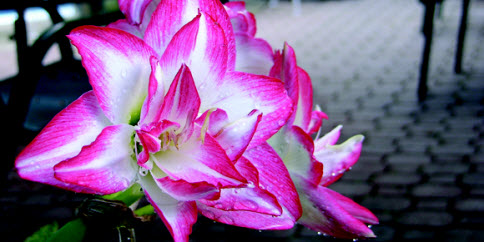Amaryllis is the de rigueur holiday season plant these days. Christmas cactus and paper whites are still fashionable, and it’s impossible to imagine poinsettias going out of style, but the big, voluptuous blooms in red, white, pink or candy-stripes have returned to the glory of their Victorian conservatory days. Everyone wants one of these beauties to bring sophistication to their holiday décor.
Now classified as Hippeastrum, the plant that is now known botanically as Amaryllis is commonly referred to as belladonna lily. We’ll stick with the old fashioned name for simplicity. Amaryllis is a native of Mexico that came to Canada as long ago as the 19th century via Holland.
Many bulbs, like tulips and paper whites, need a cold dormant period before they can bloom, but not amaryllis. Even if you never chill the plant, the plant will eventually bloom again because it is a tropical native that is not normally exposed to frost.
However, in many varieties, the leaves will die back as the plant goes into dormancy. This is normal. Reduce watering until the leaves begin to re-emerge. There are some varieties that stay evergreen all year-round. This is normal, too.
Take the plant outside and place in partial sun for the summer so that the leaves can soak up all the energy possible to produce a nice show at bloom time. You can sink the pot into the ground to guard against dehydration, if you like.
Bring it back inside before there is any danger of frost and then, If you prefer to take control over when your amaryllis blooms, force it into dormancy by keeping it in a dark, cool location with no water for about eight weeks, reducing water and keeping it at about 5°C. Depending on the variety, it will take from two weeks to a couple of months to bloom once you bring it out and water it again.
Amaryllis enjoys a crowded home and, like many of us, the bulbs increase in girth as they get older, adding about half an inch each year. You’ll need to re-pot every couple of years to accommodate the growth. If you buy the bulb in a package, choose a pot that is only an inch or two bigger than the bulb.
Leave the top third of the bulb poking up above the soil.
If you enjoy experimenting, you can also use a larger pot and allow the bulbs to produce offsets over time. They will do this quite freely, although it does take a couple of years to get blossoms from the new bulbs.
You could also conceivably collect seeds from your amaryllis and grow new plants, but the exercise is not for the impatient. First, allowing the plant’s energy to go into producing a seed will mean that there is less energy to go into developing the bulb, which means a smaller bloom from the parent plant next year. Second, the baby plant probably won’t look like the parent. And third, it will take up to five years to produce a flower. This is not so easy as buying more bulbs, but the botanically inclined aren’t necessarily looking for an easy fix!
If your plant gets good leaves but doesn’t bloom, give it a second chance before tossing it on the compost heap. Fertilize it through the growing period with a 20-20-20 all-purpose fertilizer and make sure the plant gets optimal light, avoiding strong, direct sunlight that could scorch the leaves.
Amaryllis bulbs are particularly susceptible to rot if they’re left in clammy quarters. Make sure the pot you use has drainage holes in the bottom.
When you first plant the bulb, give the soil a good soaking, letting the excess water drain out into the sink, but don’t leave the drainage tray full of water. Take particular care not to water the nose of the bulb.
After that first watering, don’t give it anything more until growth shows, and then only when the soil is dry. (If the soil dries out before you see growth, then water sparingly.) Once the plant has two nice big leaves on it, go ahead and water it about once per week.



